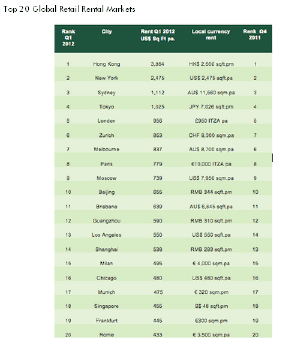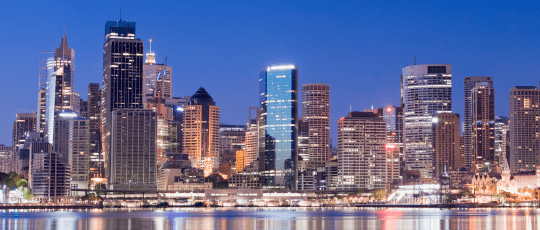Recent data has shown that the Sydney shopping district has become the third most expensive precinct in the world, as investments from international retailers and muiti-billion dollar project re-developments have increased the value of rental spaces. But these price surges in Sydney were not the only major improvements seen in Australia’s cities, as the newly revamped Brook Street Mall section in Melbourne saw rental prices increase by 20 percent, bringing Melbourne to 7th place on the international list of most expensive cities, higher than both Beijing and Paris.

These latest property figures are detailed in the Top 20 Global Retail Rental Markets report, released by CBRE, which accounts for open-market headline rental prices that are “achievable” in the 20 largest international markets. The list also includes Brisbane as the 11th most expensive city internationally, as mall developments (such as those from companies like Westfield and Myer) have increased the value of rental properties nationwide across Australia.
Strong Investment Opportunities Still Seen in Melbourne
According to the CBRE survey, these increases in property values have come mostly from the fact that increased competition for rental space from foreign retail shops is seen limiting the supply of available space, making it difficult for new buyers to find desirable storefronts. The CBRE report showed that average rental prices in Sydney are now valued at $11,560 per square meter (per annum), while in Melbourne typical rental prices can be found at $8,700 per square meter (per annum).
The report goes on to say that top-tier rental prices remain higher in Sydney than in Melbourne, and this is being viewed as a positive for retailers looking to gain less expensive exposure to the prime real estate that is currently available in Melbourne’s strong retail market. With analysts expecting the underlying pace of rental price growth in both Sydney and Melbourne to narrow, it looks as though some excellent investment opportunities exist in Melbourne’s lesser-known locations.
Property Markets Continue to See Modest Increases Despite Uncertain Global Environment

Looking at other areas of the world, the report shows that Hong Kong is now most expensive retail space for tourist-focused shopping outlets, as a strong foreign consumer base and increased domestic wealth continue to attract luxury retailers and well-known names in the international fashion industry. From a global perspective, worldwide rental prices increased by a relatively modest 0.8%, but this should still be viewed as a positive given the uncertain economic environment that has been created by the Eurozone debt crisis and its potentially negative contagion effects.
In the first quarter of 2012, these concerns took a firm hold and weighed heavily on consumer confidence and retail sales figures, creating a climate of slowing economic growth on a global level. So the fact that rental prices manage to gain at all during this period should be viewed favorably, as the world’s financial situation continues to recover.
Continuing Outlook for Australia’s Retail Properties
Going forward, analyst reports are suggesting that the introduction of new fashion labels (along with the added appeal of technology outlets from companies like Apple and Samsung) will continue to keep the prime retail district supported in Sydney, with associated investments in these areas maintaining a high level of profitability. These arguments center mostly on the fact that property supply levels in the busy pedestrian thoroughfares remain low while demand for space in these areas remains elevated.
Australian property markets remain relatively insulated from external economic shocks, so any malaise that could be seen in the retail sector (stemming from potential shifts in shopping habits) is likely to have only a limited effect on the region’s property values. With retail vacancy rates in Sydney’s core shopping areas (Martin Place, Market and George streets, and Castlereagh) holding at roughly 3.1%, continued interest from luxury brands and internationally known retailers will likely provide sustainable opportunities for the larger retail centers and other stand-alone premises in preferred locations. Outside of these core areas, service outlets and lower to mid range fashion stores will continue to attract a good deal of run-off from these areas as workers and tourists support other businesses in these areas.




